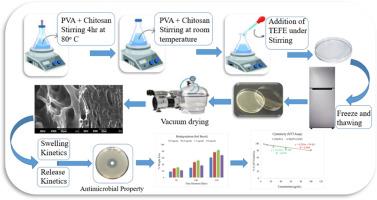Development of chitosan based hydrogels with marigold flower extract: An innovative, low cost, biodegradable and antimicrobial solution for enhanced wound healing applications
引用次数: 0
Abstract
Marigold (Tagetes erecta), constitutes a commonly utilized floral resources in craft applications, frequently facing discard despite its intrinsic potential for diverse applications. It is an ingredient in ethno medicines and contains several bioactive compounds, including essential oils, carotenoids, flavonoids, terpenoids, thiophenes, and phenolic compounds. T. erecta flower extract is well-known for its antibacterial, anti-inflammatory, and antioxidant activities, as well as wound-healing effects. Therefore, the present research aims to explore its wound-healing potential by incorporating it into a hydrogel-based matrix. Hydrogel wound dressings could create a moist environment that accelerates wound healing by providing a base for epithelial tissue development, and shielding wounds. For the first time, the chitosan-based herbal hydrogels were prepared by encapsulating the aqueous extract of TEFE using the freeze-thaw method. The flower extract was successfully incorporated into pH-sensitive chitosan herbal gels to deliver the extract to infected wounds while preserving its biological activities. The release kinetics of the hydrogels were evaluated under different environmental conditions to determine the TEFE release behaviour. The hydrogel system demonstrated a prolonged release of the floral extract for up to 7 days. Furthermore, the hydrogel formulation exhibited strong antimicrobial activity against Escherichia coli, Staphylococcus aureus, and Candida albicans. The TEFE-loaded hydrogels also demonstrated promising antidiabetic potential through inhibition of α-amylase (43.5 %) and α-glucosidase (49.3 %), suggesting applicability in diabetic wound care. The chitosan hydrogels encapsulating TEFE were biodegradable, with remarkably high degradability observed after 21 days of exposure to soil. The MTT assay of the CHS-TEFE herbal hydrogel using mouse L929 cell lines confirmed its non-toxic nature, highlighting its potential as a safe and effective delivery system for managing open skin wounds through localized application.

基于万金菊提取物的壳聚糖水凝胶的开发:一种创新、低成本、可生物降解和抗菌的解决方案,用于增强伤口愈合应用
万寿菊(Tagetes erecta)是一种在工艺应用中被普遍利用的花卉资源,尽管其内在的多种应用潜力,但经常面临丢弃。它是民族药的一种成分,含有几种生物活性化合物,包括精油、类胡萝卜素、类黄酮、萜类、噻吩和酚类化合物。直立木花提取物以其抗菌、抗炎和抗氧化活性以及伤口愈合作用而闻名。因此,本研究旨在通过将其结合到水凝胶基基质中来探索其伤口愈合潜力。水凝胶伤口敷料可以创造一个湿润的环境,通过为上皮组织的发育提供基础,加速伤口愈合,并保护伤口。首次采用冻融法将TEFE水提物包封,制备了壳聚糖基草药水凝胶。将花提取物成功地掺入ph敏感壳聚糖草药凝胶中,在保持其生物活性的同时将提取物输送到感染伤口。考察了水凝胶在不同环境条件下的释放动力学,以确定TEFE的释放行为。水凝胶系统证明了花提取物的延长释放长达7天。此外,水凝胶制剂对大肠杆菌、金黄色葡萄球菌和白色念珠菌具有较强的抗菌活性。负载tefe的水凝胶还通过抑制α-淀粉酶(43.5%)和α-葡萄糖苷酶(49.3%)显示出良好的降糖潜力,提示其在糖尿病伤口护理中的适用性。包封TEFE的壳聚糖水凝胶是可生物降解的,暴露于土壤21天后,降解率显著提高。使用小鼠L929细胞系对CHS-TEFE草药水凝胶进行MTT试验,证实了其无毒性质,突出了其作为一种安全有效的局部应用给药系统治疗开放性皮肤伤口的潜力。
本文章由计算机程序翻译,如有差异,请以英文原文为准。
求助全文
约1分钟内获得全文
求助全文

 求助内容:
求助内容: 应助结果提醒方式:
应助结果提醒方式:


